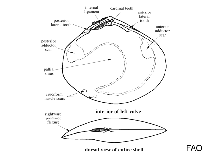Abra nitida (Müller, 1776)
Warning: DOMDocument::load(): SSL operation failed with code 1. OpenSSL Error messages: error:140770FC:SSL routines:SSL23_GET_SERVER_HELLO:unknown protocol in C:\Apache24\htdocs\includes\SpeciesSummary.lib.php on line 1236
Warning: DOMDocument::load(): Failed to enable crypto in C:\Apache24\htdocs\includes\SpeciesSummary.lib.php on line 1236
Warning: DOMDocument::load(https://sealifebase.nrm.se/webservice/AquaMaps/getAMap.php?genus=Abra&species=nitida): failed to open stream: operation failed in C:\Apache24\htdocs\includes\SpeciesSummary.lib.php on line 1236
Warning: DOMDocument::load(): I/O warning : failed to load external entity "https://sealifebase.nrm.se/webservice/AquaMaps/getAMap.php?genus=Abra&species=nitida" in C:\Apache24\htdocs\includes\SpeciesSummary.lib.php on line 1236
Upload your photos
Google image | No image available for this species;
drawing shows typical species in Semelidae.
Google image | No image available for this species;
drawing shows typical species in Semelidae.
Classification / Names Common names | Synonyms | CoL | ITIS | WoRMS
| Cardiida | Semelidae
Environment: milieu / climate zone / depth range / distribution range Ekologi
; djupintervall 24 - 4400 m (Ref. 123853). Temperate; 71°N - 31°N, 11°W - 29°E
Utbredning Länder | FAO områden | Ekosystem | Förekomster | Utplanteringar
Eastern Atlantic and the Mediterranean: from Morocco to northern Norway, and east to Romania.
Length at first maturity / Size / Vikt / Age
Maturity: Lm ? range ? - ? cmrapporterad maxålder: 2.00 år (Ref. 2823)
A surface deposit feeder (Ref. 96501). Found offshore at 80 m depth (Ref. 2823). Mainly found in muddy sediments but also lives in fine sand (Ref. 123853). Main food and feeding type based on another species of the same genus; to be replaced with a better reference (Ref. 88171).
Life cycle and mating behavior Könsmognad | Reproduktion | Lek | Ägg | Fecundity | Larver
Members of the class Bivalvia are mostly gonochoric, some are protandric hermaphrodites. Life cycle: Embryos develop into free-swimming trocophore larvae, succeeded by the bivalve veliger, resembling a miniature clam.
Main reference
referenser | Koordinator | Medarbetare
López-Jamar, E., G. González and J. Mejuto. 1986. (Ref. 2778)
IUCN Red List Status (Ref. 130435)
CITES status (Ref. 108899)
Not Evaluated
CMS (Ref. 116361)
Not Evaluated
Threat to humans
Human uses
| FishSource |
Verktyg
Ytterligare information
Internet-källor
BHL | BOLD Systems | CISTI | DiscoverLife | FAO(Publication : search) | Fishipedia | GenBank (genome, nucleotide) | GloBI | Gomexsi | Google Books | Google Scholar | Google | PubMed | Tree of Life | Wikipedia (Go, sök) | Zoological Record
Estimates based on models
Price category
(Ref. 80766):
Unknown.



